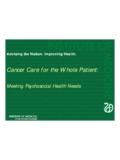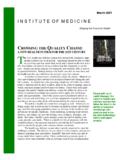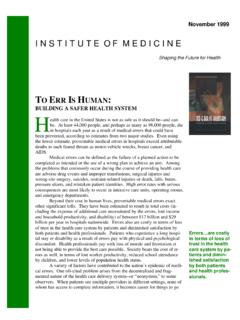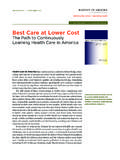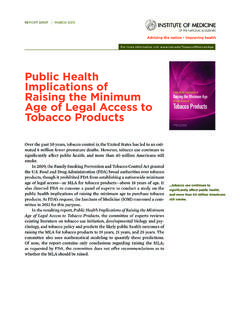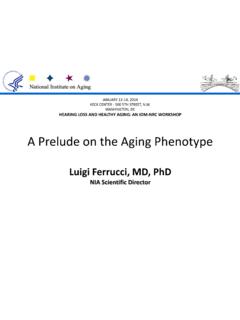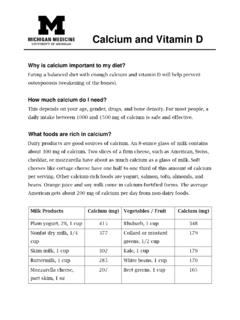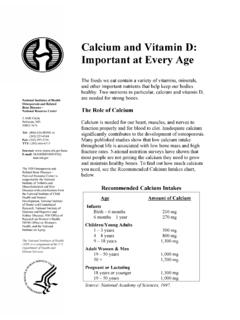Transcription of Dietary Reference Intakes for Calcium and Vitamin D
1 REPORT BRIEF NOVEMBER 2010. For more information visit Dietary Reference Intakes for Calcium and Vitamin D. Calcium and Vitamin D are two essential nutrients long known for their role in bone health. Over the last ten years, the public has heard conflicting messages about other benefits of these nutrients especially Vitamin D and also about how much Calcium and Vitamin D they need to be healthy. To help clarify this issue, the U. S. and Canadian governments asked the Institute of Medicine (IOM) to assess the current data on health outcomes associated with Calcium and Vitamin D. The IOM tasked a committee of experts with reviewing the evidence, as well as updating the nutrient Reference values, known as Dietary Reference Intakes (DRIs). These values are used widely by The committee provided an government agencies, for example, in setting standards for school meals or exhaustive review of studies on specifying the nutrition label on foods.
2 Over time, they have come to be used potential health outcomes and by health professionals to counsel individuals about Dietary intake. found that the evidence supported The committee provided an exhaustive review of studies on potential a role for these nutrients in bone health but not in other health health outcomes and found that the evidence supported a role for these nutri- conditions. ents in bone health but not in other health conditions. Further, there is emerg- ing evidence that too much of these nutrients may be harmful. Health Effects of Vitamin D and Calcium Intake The new Reference values are based on much more information and higher- quality studies than were available when the values for these nutrients were first set in 1997. The committee assessed more than one thousand studies and reports and listened to testimony from scientists and stakeholders before mak- ing its conclusions.
3 It reviewed a range of health outcomes, including but not limited to cancer, cardiovascular disease and hypertension, diabetes and met- abolic syndrome, falls, immune response, neuro- ment (EAR)s and the Recommended Dietary psychological functioning, physical performance, Allowances (RDA), that are intended to serve preeclampsia, and reproductive outcomes. This as a guide for good nutrition and to provide the thorough review found that information about basis for the development of nutrient guidelines the health benefits beyond bone health benefits in both the United States and Canada. The EAR. often reported in the media were from stud- is used for planning and assessing diets of popu- ies that provided often mixed and inconclusive lations; it also serves as the basis for calculating results and could not be considered reliable. the RDA, a value intended to meet the needs of However, a strong body of evidence from rigorous nearly all people.
4 The RDA for Calcium for chil- testing substantiates the importance of Vitamin D dren ages 1 through 3 is 700 milligrams that and Calcium in promoting bone health. amount of Calcium per day will meet the needs of almost all children in that age range. One thou- sand milligrams daily is appropriate for almost Dietary Reference Intakes all children ages 4 through 8. Adolescents need higher levels to support bone growth: 1,300 mil- The DRIs are a family of nutrient Reference val- ligrams per day meets the needs of nearly all ado- ues, including the Estimated Average Require- TABLE: Dietary Reference Intakes for Calcium and Vitamin D. Calcium Vitamin D. Estimated Recommended Estimated Recommended Average Dietary Upper Level Average Dietary Upper Level Life Stage Group Requirement Allowance Intake Requirement Allowance Intake (mg/day) (mg/day) (mg/day) (IU/day) (IU/day) (IU/day).
5 Infants 0 to 6 months * * 1,000 ** ** 1,000. Infants 6 to 12 months * * 1,500 ** ** 1,500. 1 3 years old 500 700 2,500 400 600 2,500. 4 8 years 800 1,000 2,500 400 600 3,000. 9 13 years old 1,100 1,300 3,000 400 600 4,000. 14 18 years old 1,100 1,300 3,000 400 600. 19 30 years old 800 1,000 2,500 400 600 4,000. 31 50 years old 800 1,000 2,500 400 600 4,000. 51 70 year old males 800 1,000 2,000 400 600 4,000. 51 70 year old females 1,000 1,200 2,000 400 600 4,000. >70 years old 1,000 1,200 2,000 400 800 4,000. Advising the nation / Improving health 14 18 years old, 1,100 1,300 3,000 400 600 4,000. pregnant/lactating 500 Fifth Street, NW. Washington, DC 20001. 19 50 years old, 800 1,000 TEL 2,500 400 600 4,000. pregnant/lactating FAX *For infants, Adequate Intake is 200 mg/day for 0 to 6 months of age and 260 mg/day for 6 to 12 months of age.
6 **For infants, Adequate Intake is 400 IU/day for 0 to 6 months of age and 400 IU/day for 6 to 12 months of age. 2. Higher levels of both nutrients have not been shown to confer greater benefits, and in fact, they have been linked to other health problems, challenging the concept that more is better.. lescents. For practically all adults ages 19 through Vitamin D presents a complicated picture. While 50 and for men until age 71, 1,000 milligrams the average total intake of Vitamin D is below covers daily Calcium needs. Women over 50 and the median requirement, data from these sur- both men and women 71 and older need no more veys show that average blood levels of Vitamin than 1,200 milligrams per day to ensure they D are above the 20 nanograms per milliliter that are meeting their daily needs for strong, healthy the IOM committee found to be the level that is bones (see table for additional information).
7 Needed for good bone health for practically all Determining intake levels for Vitamin D is individuals. These seemingly inconsistent data somewhat more complicated. Vitamin D levels in suggest that sun exposure currently contributes the body may come from not only Vitamin D in the meaningful amounts of Vitamin D to North Amer- diet but also from synthesis in the skin through icans and indicates that a majority of the popula- sunlight exposure. The amount of sun exposure tion is meeting its needs for Vitamin D. Nonethe- one receives varies greatly from person to per- less, some subgroups particularly those who are son, and people are advised against sun exposure older and living in institutions or who have dark to reduce the risk of skin cancer. Therefore, the skin pigmentation may be at increased risk for committee assumed minimal sun exposure when getting too little Vitamin D.
8 Establishing the DRIs for Vitamin D, and it deter- Before a few years ago, tests for Vitamin D. mined that 600 International Units (IUs) of vita- were conducted infrequently. In recent years, min D per day meets the needs of almost everyone these tests have become more widely used, and in the United States and Canada (see table). Peo- confusion has grown among the public about how ple age 71 and older may need as much as 800 IUs much Vitamin D is necessary. Further, the mea- per day because of potential changes in people's surements, or cut-points, of sufficiency and defi- bodies as they age. ciency used by laboratories to report results have not been set based on rigorous scientific studies, and no central authority has determined which Questions About Current Intake cut-points to use. A single individual might be deemed deficient or sufficient, depending on the National surveys in both the United States and laboratory where the blood is tested.
9 The num- Canada indicate that Calcium may remain a nutri- ber of people with Vitamin D deficiency in North ent of concern, especially for girls ages 9 18. Some America may be overestimated because many postmenopausal women taking supplements may laboratories appear to be using cut-points that be getting too much Calcium , thereby increasing are much higher than the committee suggests is their risk for kidney stones. appropriate. Information from national surveys shows 3. Committee to Review Dietary Reference Intakes for Vitamin Tolerable Upper Levels of Intake D and Calcium The upper level Intakes set by the committee for A. Catharine Ross (Chair) Glenville Jones both Calcium and Vitamin D represent the safe Professor of Nutrition and Head, Department of Biochem- Occupant of Dorothy Foehr istry and Professor of Bio- boundary at the high end of the scale and should Huck Chair in Nutrition, Penn- chemistry & Medicine, Queens sylvania State University University, Ontario not be misunderstood as amounts people need or Steven A.
10 Abrams Professor of Pediatrics, Baylor Christopher S. Kovacs Professor of Medicine (Endocri- should strive to consume. While these values vary College of Medicine nology), Memorial University of Newfoundland somewhat by age, as shown in the table, the com- John F. Aloia Professor, SUNY at Stony Joann E. Manson mittee concludes that once Intakes of Vitamin D. Brook, Chief Academic Officer, Professor of Medicine and the Winthrop-University Hospital Elizabeth Brigham Professor of surpass 4,000 IUs per day, the risk for harm begins Women's Health, Harvard Patsy M. Brannon Professor, Division of Medical School to increase. Once Intakes surpass 2,000 milligrams Nutritional Sciences, Cornell University Susan T. Mayne Professor of Epidemiology and per day for Calcium , the risk for harm also increases. Steven K. Clinton Public Health, Yale School of Public Health As North Americans take more supplements Professor, Division of Hematol- ogy and Oncology, The Ohio Clifford J.

